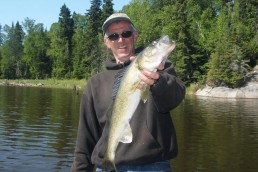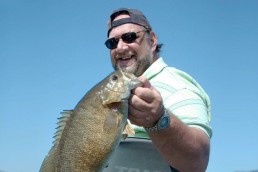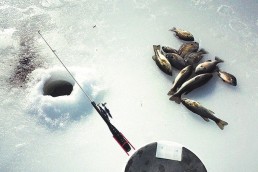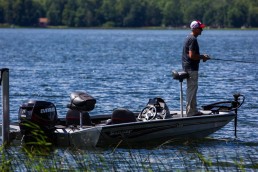Floats: Early Spring’s Best Answer to Panfish and Gamefish
SHARE THIS POST
Over the years I’ve targeted walleyes, bass, perch, bluegills, steelhead, crappies, catfish, pike, brown trout and white bass, all with a bobber, or to be precise, a float. Some anglers snuff their noses at floats, but talk with any guide and they will show you a handful of floats—guides for walleyes on northern lakes all carry floats. One I know uses floats 50 percent of the time.
Floats perform two tasks perfectly: they keep your lure or bait exactly at the depth you desire and are a spectacular strike indicator. You have fixed floats and slip floats. A fixed float is attached to your line and stays at that exact depth; a slip float is adjustable for any depth, and my favorite.
I carry one rod with a slip float all season. The slip float is adjustable from the shallow depths to depths pushing 30 feet or more. Some floats are designed for current or heavy winds, while others are slender like a porcupine quill. You also have weighted slip floats that cast great and stand up vertically in an instant. I like the Weighted Slip Floats from Carlisle when chasing down pike, bass and walleyes.
Slip floats are great when panfish are feeding on the surface or just below. Set the float depth at 2 feet with an ice fishing teardrop or a spider. Tip it with a spike or a waxworm. Otherwise, use an ice ant or a hackle jig. These very small ice jigs will sink ever so slowly and the hungry panfish can suck them in without feeling any resistance.
At ice-out, a casting float and a fly are killer on ‘gills and specks. The ‘gills will be found in canals, channels and shallow bays or feeding on the surface over very deep water. Countless evenings, we enjoyed success casting a small casting torpedo float with a fly or ant hanging back 5 feet—one slurp and your line would go tight.
Other early spring days, the shallowest waters would hold huge schools of hand-sized ‘gills. Casting a slip float with a spider or an ant and allowing it to slowly sink would trigger the weariest of ‘gills, with no sinker, just the spider and the waxworm.
Another technique is one often overlooked: If you do not have a graph then this technique is for you. Fish swim rafts that are out beyond the drop-offs. The bluegills just love shade. Ask anyone that snorkels on your favorite lake, and they will tell you how often they’ve found big ‘gills under a raft in deep water.
The best rafts are those not used all of the time. You can literally catch your limit from one raft. A raft or dock that sits close to the water’s surface and has some cobwebs showing is the prime spot. When raft fishing, set your bobber very shallow.
Just before sunset, look for ripples or rings on the surface. Regardless of depth, a school of ‘gills will often start feeding on the surface. And a slip bobber set for 2 feet without any sinker or weight is deadly.
Pike or muskies in fall can be great with a large sucker minnow floating 2 to 4 feet down over and alongside a cabbage weed patch. Use the biggest sucker minnows or chubs. Hook your bait with a quick-strike rig to avoid gut-hooking the fish. A quick strike rig has two hooks: one goes into the mouth and the other under the dorsal fin parallel to the fish’s body of the bait.
Most opening days of pike fishing includes my bread and butter bait. One rod is rigged with a lively sucker minnow and the second rod is with a frozen smelt. Work the flats closest to an inlet for better the action. If small perch are in your lake, search them out. Knocked down weeds and debris hold small perch, and hungry pike will cruise these areas with the warm sun rising.
Walleyes love rock, riprap, humps and sharp breaklines. And there is hardly a better way to fish rocks than with a slip bobber. In this case, we use the multi-colored jig heads, and my favorite bait is a leech. A light-hooked leech dances and wiggles tirelessly and uncontrollably in water. We have a lake where our best fishing comes from a long dock bordering a deep drop-off. All of the guys grab a chair, a cold drink one and throw out floats. However, for early and late in the season, nothing beats a good 3- to 4-inch minnow. Hook the minnow through the lips for the best action. We often add a stinger hook when using the larger minnows with a jig head. A small number 8 or 10 stinger hook lands big walleyes without impeding minnows.
Are you enjoying this post?
You can be among the first to get the latest info on where to go, what to use and how to use it!
We spent a few days on Lake Leelanau in August last year and enjoyed great walleye action. The walleyes were holding tight to the short grass in 18 feet of water. Our graph showed the short grass and the slightly suspended fish.
This long bar was maybe 200 yards long, but varied between 3 and 10 feet wide. Just above this sweet spot, the water shallowed up and just below it was a fast drop-off. Perhaps you could have worked this location over with a Lindy Rig, but the slip float put the hurt on the fish three nights in a row.
I know that the die-hard bass anglers will not like hearing this, but a leech or a minnow under a float is deadly on both largemouth and smallmouth bass. We use circle hooks when targeting fish we plan on returning because 90 percent of the hooked fish will be caught in the corner of the mouth. Circle hooks can be used for all fish, and another great trait of the circle hook is that the fish often hooks itself on it.
People pay big money to fish with shiners in Florida for big bass. Nearly all of the guides run shiners in January, February and into March—we are talking 4- to 6-inch baits or larger. Fishing shiners or minnows is best near cover. Lily pads, cattails or any type of wood or newly emergent weeds will hide a bass. Your best bass locations include rock, riprap, the deep side of the weedline, and, once fall arrives, the shorelines where the majority of the frogs are at.
Steelhead anglers like to float single eggs and spawn sacs over the reeds and into a log-jammed deep hole. The float rig snags much less than when rolling the spawn directly on the bottom. You can paint the tips with glow paint when fishing under the cover of darkness. Fishing a float is a precise instrument and extremely versatile.
A jig head provides weight and color and is my first choice on walleyes. For crappies or bluegills, we normally place a glow- in-the-dark teardrop or a rubber spider with glow-in-the-dark legs.
A nice jumbo leech works wonders for the bass and the walleyes. And when targeting just bass, we use a circle hook because it sets the hook itself and 95 percent of the fish will be hooked in the jaw and can be released.
Minnows work great for the crappies, and a waxworm or a small leaf worm is just dandy on the bluegills.
Anglers should carry one rod rigged with a slip float all season; it is very deadly and easy to master. I can’t think of a better way to fish crappies during the dog days of summer than with a green light and slip floats with the tips doused in glow paint. And, the action after dark is four times better than during the daylight.
Slip floats are perfect for a family outing where skill levels vary. They offer a pinpoint presentation, perfect depth control, are a great visual aid and extremely productive on any species that swims. The slip bobber is adjustable. Just move the bobber stop up or down to match the depth that you need. This is one reason why I like a slip bobber. You can fish 20 feet down and in a minute have your bobber set for the surface feeders.
From ice-out to ice-over, floats are deadly and often the best choice to fish with.
MWO
SHARE THIS POST
Did you enjoy this post?
You can be among the first to get the latest info on where to go, what to use and how to use it!
Jack Payne
Jack Payne is an accomplished angler and hunter who enjoys teaching others as much as learning from others. Seminar speaker, outdoor photography enthusiast, hunter safety instructor and volunteer at many events for both kids and adults as an instructor.



